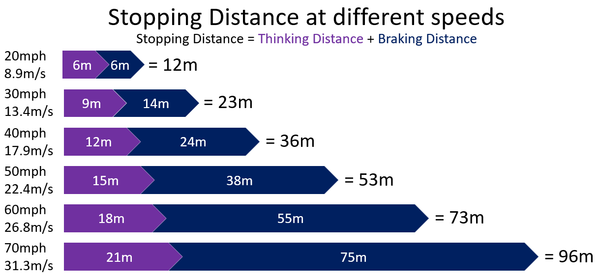Difference between revisions of "Stopping Distance"
| Line 12: | Line 12: | ||
'''Stopping distance''' depends on: | '''Stopping distance''' depends on: | ||
*The [[speed]] of the vehicle - The greater the [[speed]] the larger the '''stopping distance'''. | *The [[speed]] of the vehicle - The greater the [[speed]] the larger the '''stopping distance'''. | ||
| − | *The [[Human Reaction Time|reaction time]] of the driver - The longer the [[Human Reaction Time|reaction time]] the longer the [[Thinking | + | *The [[Human Reaction Time|reaction time]] of the driver - The longer the [[Human Reaction Time|reaction time]] the longer the [[Thinking Distance|thinking distance]] and therefore '''stopping distance'''. |
*The conditions of the road and tyres - The less [[friction]] between the road and tyres the longer the [[Braking Distance|braking distance]] and therefore '''stopping distance'''. | *The conditions of the road and tyres - The less [[friction]] between the road and tyres the longer the [[Braking Distance|braking distance]] and therefore '''stopping distance'''. | ||
Revision as of 10:56, 17 February 2019
Key Stage 4
Meaning
Stopping distance is the distance a vehicle travels between the driver noticing a hazard and coming to a stop.
About Stopping Distance
Stopping distance is made of two parts:
- Thinking Distance - The distance travelled by the vehicle between noticing a hazard and putting the foot on the brakes.
- Braking Distance - The distance travelled once the vehicle has applied the brakes.
Stopping Distance = Thinking Distance + Braking Distance
Stopping distance depends on:
- The speed of the vehicle - The greater the speed the larger the stopping distance.
- The reaction time of the driver - The longer the reaction time the longer the thinking distance and therefore stopping distance.
- The conditions of the road and tyres - The less friction between the road and tyres the longer the braking distance and therefore stopping distance.
